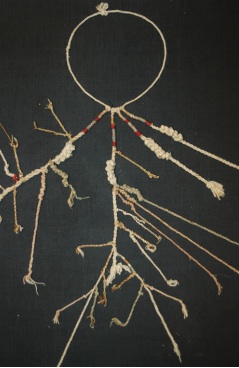Language, Khipus, and Pre-Inca Civilization

The civilizations of the Andes are distinctive in so many ways. One though continues to amaze investigators and tourists alike. How did they develop such high civilization without means of writing recognizable to us?
Many people have pointed out the knotted cords called khipus in English and quipus in Spanish probably filled much of the role of writing and counting for the purposes of administration and possibly much more.
As a result, an intense international effort has developed to understand means of scribing in the Andes and especially to try to make sense of the khipu.
One of the leading scholars in this endeavor is anthropologist Gary Urton who recently published a study of Middle Horizon knotted cords, which he does not call khipus in order to keep a distinction clear. These are from well before the Incas. In part he is posing the question of whether Inca khipus are sui generis in their complexity, structure, and form, or if they stem from earlier practices of using knotted chords.
For this study he relied on a small collection of cords, 17, scattered among museums and with one in a private collection that date from before the Incas.

Urton notices that there are both similarities and differences between these cords from the Wari civilization and those from the Incas. Perhaps the biggest difference is the fact that the earlier ones are constructed on a base five system while the Incas are built on a base ten.
This means that the Middle Horazon knotted cords relied on a system of counting that had five numbers and composed more by repeating the sequence with modifiers. In contrast the Incas relied on a system of ten numbers which then were repeated with modifications.
Although there is no clear means of transmission between the Middle Horizon and the Incas, Urton argues these khipus lay a foundation for the Inca practice that was developed much before them.
He spends time on the numerical issue by going to the three native languages known to be spoken in the southern highlands at the time of the Incas: Quechua, Puquina, and Aymara.

Of these, Aymara is the language that shows evidence of having a base five counting system. Its numerals are maya, paya quimsa, pusi pisqa, soqta, paqallqu, quimsaqallqu, llatunka, and tunka. Of these, he argues that five, six, and ten were borrowed from Quechua as was ten. He argues, significantly that the earlier word for five was qallqu.
Urton then focuses on seven and eight as showing the use of prefixes attached to an earlier numeral to make a larger one. For this he notes that seven is five (qallqu–an earlier form replaced later by the Quechua five, pisqa) plus two (paya or pa in this reduction). Eight is the same five plus three.
As a result, he sustains the arguments that claim the official language of the Wari Empire was Aymara, while the Inca and the earlier Tiwanaku empire of the high plateau by Lake Titicaca was likely Puquina, which has a base ten system. Quechua, though also having a base ten and adopted by the Incas as the language of government, came from elsewhere than the homeland of the Incas in Cusco.
As scholars continue to sift through the nature and use of khipus, Urton makes powerful arguments that will continue to demand additional scholarship from his host of students and others.
Reference: Gary Urton. From Middle Horizon cord-keeping to the rise of Inka khipus in the central Andes, ANTIQUITY 88 (2014): 205–221. http://antiquity.ac.uk/ant/088/ant0880205.htm




